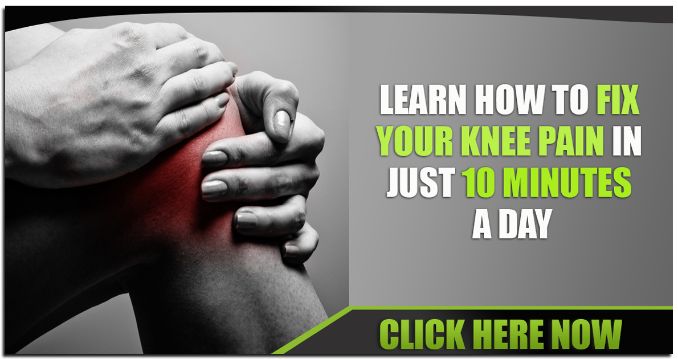If you've been dealing with knee pain, you know how limiting it can be. The good news is that exercises are tailored to strengthen and support your knees, helping you regain mobility and reduce discomfort. In this article, we'll explore a range of exercises for bad knees, from gentle stretches to targeted strengthening exercises and routines. Whether recovering from an injury or managing chronic knee issues, these exercises can significantly impact your overall well-being.
Understanding Knee Pain and its Causes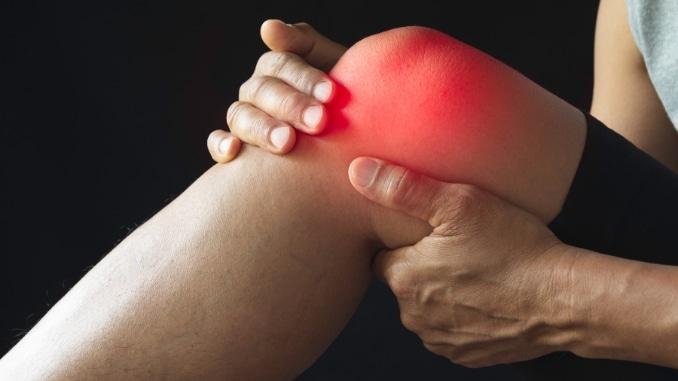
Knee pain has the potential to be incapacitating and can have a substantial effect on your overall quality of life. Understanding the causes of the pain is essential to finding the right exercises for relief.
Several factors can contribute to bad knees, including:
- Arthritis: Various forms of arthritis, including rheumatoid arthritis, osteoarthritis, and other related conditions, may lead to inflammation and rigidity within the knee joints, resulting in discomfort and restricted movement.
- Ligament Injuries: Tears or sprains in the knee's ligaments, like anterior cruciate ligament (ACL) or medial collateral ligament (MCL), can result in chronic pain and instability.
- Meniscus Tears: The meniscus is a pliable cartilaginous component, acting as a cushioning mechanism, positioned between the thigh bone and ankle or the thigh muscle and shinbone. Tears in the meniscus can cause knee pain, especially when twisting or rotating the joint.
- Overuse or Repetitive Strain: Activities that involve repetitive movements or excessive stress on the knees, such as running or jumping, can lead to inflammation, pain, and, eventually, chronic knee problems.
- Obesity: Carrying excessive weight strains the knees, increasing the risk of developing knee pain and joint problems.
The Importance of Knee Exercise for Knee Health

When faced with knee pain, it may be tempting to avoid physical activity altogether. However, regular exercise is crucial for maintaining knee health and reducing discomfort. Exercise helps to:
- Strengthen the surrounding thigh muscles: Strong muscles around the knee joint can provide added support and stability, reducing the pressure on the knees.
- Improve flexibility and range of motion: Gentle stretches and mobility exercises can help increase flexibility, making it easier to accomplish daily activities without pain or stiffness.
- Promote weight management: Maintaining a healthy weight minimizes knee stress. Regular exercise can help torch calories and manage body weight effectively.
- Enhance joint lubrication: Physical activity stimulates the creation of synovial fluid, which lubricates the joints and reduces friction, resulting in smoother movement and reduced pain.
What Exercises Are Good for Bad Knees
Regarding exercises for bad knees, not all activities are created equal. It's important to choose exercises that are low-impact and gentle on the joints.
Here are some of the best practices for individuals with bad knees:
- Swimming and Water Aerobics: Water exercises are excellent for individuals with knee pain as they provide resistance without putting stress on the joints. Swimming and water aerobics help strengthen the thigh muscles around the knees while improving cardiovascular fitness.
- Cycling: Cycling is a moderate activity that can benefit bad knees. Whether using a stationary bike or cycling outdoors, this exercise helps strengthen the quadriceps and hamstring muscles while minimizing knee stress.
- Yoga and Pilates: These mind-body practices focus on gentle stretching, flexibility, and core strength. Both yoga and pilates offer modifications and variations for individuals with knee pain, making them ideal for improving mobility and reducing discomfort.
- Tai Chi: Tai Chi is a light martial art that involves slow, fluid movements and deep breathing. This ancient practice helps improve balance, flexibility, and overall joint health, making it an excellent option for individuals with bad knees.
- Strength Training: It is essential to build strength in the muscles surrounding the knees to maintain optimal knee health. When performed correctly and properly, leg presses, straight leg raises, squats, lunges, and leg-bent exercises can help foster strength and stability in the knee joints.
It's important to note that when starting any exercise routine for bad knees, you must listen to your body and start slowly. To prevent worsening pain, progressively raise the intensity and length of your workouts.
Factors to Consider Before Starting a Routine
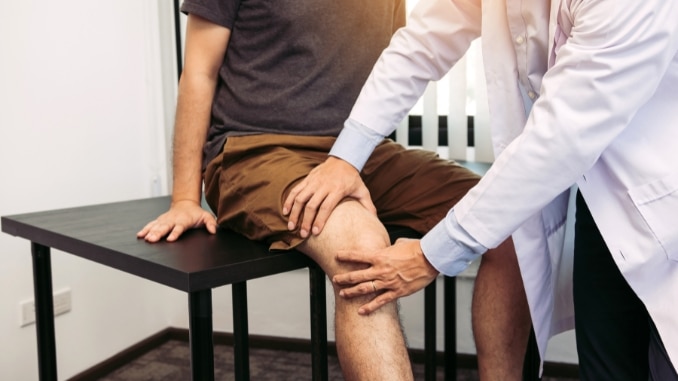
Before embarking on an exercise regimen designed for problematic knees, it's important to take into account several factors to ensure your safety and optimize the advantages:
- Seek guidance from a healthcare professional: If you're dealing with chronic knee pain, it's advisable to consult with a healthcare expert before initiating any fresh exercise routine. They can offer tailored recommendations considering your unique condition and medical background.
- Modify exercises as needed: Not all activities suit your current condition. Modify workouts to accommodate your level of comfort and pain tolerance. For example, if lunges are too challenging, start with partial lunges or use a chair for support.
- Warm up and cool down: Before commencing your exercise routine, engaging in a warm-up is essential to ready your muscles and joints for physical activity. Similarly, cool down with gentle stretches to prevent muscle stiffness and reduce post-workout soreness.
- Use proper footwear: Wearing supportive and well-fitting shoes is crucial for knee health. Invest in shoes that provide adequate cushioning and stability to minimize the impact on your knees during exercise.
- Listen to your body: Pay attention to any discomfort or pain during your exercises. If an exercise causes sharp or worsening pain, stop immediately and talk with a healthcare professional.
By considering these factors and taking a cautious approach, you can create a safe and effective exercise routine for your knees.
5 Best Exercises for Bad Knees
1. Hip Hinges
Begin in an upright standing position with your legs hip-width apart, maintaining good alignment with your head, shoulders, hips, and legs. Engage your core. Slightly bend your knees and pivot through your hips to bend your upper body forward, ideally parallel to the floor. Slowly raise to return to the starting position and repeat the movement.
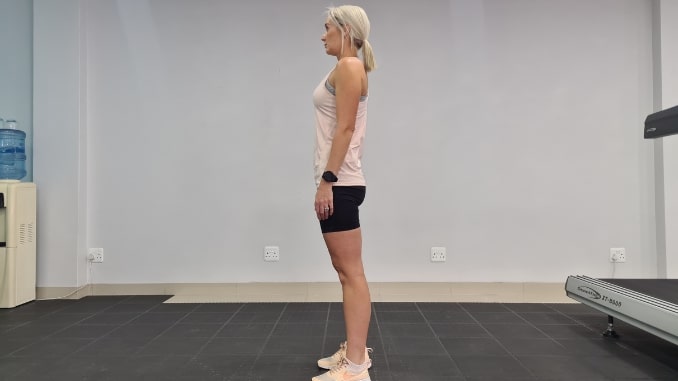 |
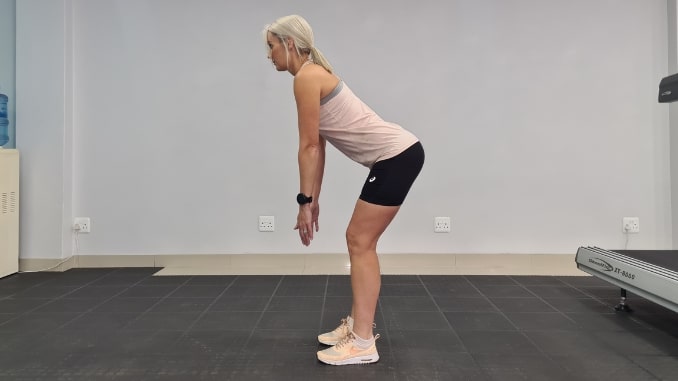 |
2. Single Leg Deadlift
For this exercise, you can use the back of the chair, wall, or anything stable for balance.
Begin in an upright standing position with your feet shoulder-width apart, maintaining good alignment with your head, shoulders, hips, and legs. Bring your hands to your sides and engage your core. Shift your weight onto one leg and slightly bend your supporting knee. Hinge your hips, bending forward until your upper body is parallel to the floor while extending your other leg straight back. Raise back up to return to the starting position and repeat the movement. After several repetitions, perform the movement on the opposite leg. Start with 1 set of 10 repetitions on each side.
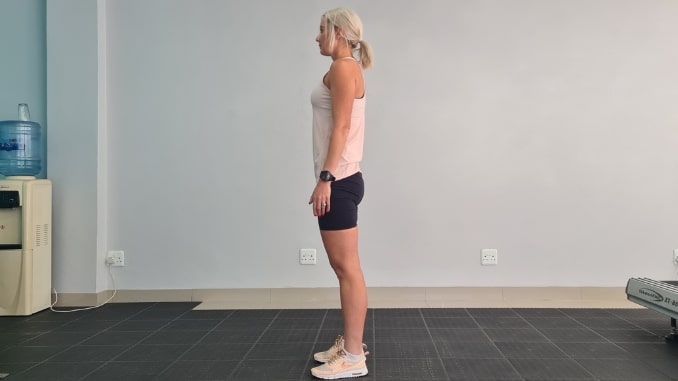 |
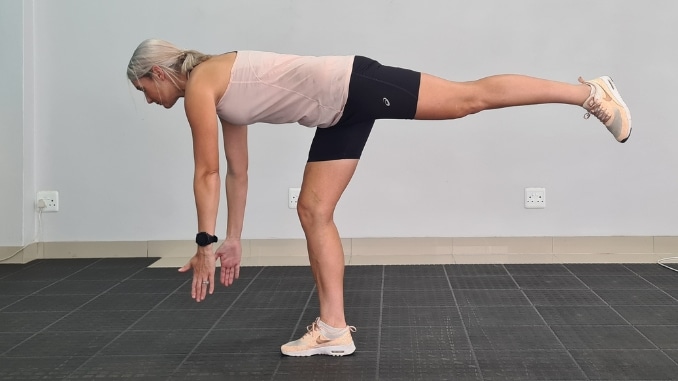 |
3. Standing Back Arch
Begin in an upright standing position with your legs shoulder-width apart, maintaining good alignment with your head, shoulders, hips, and legs. Place your hands on your hips or pelvis area. Engage your core and arch your back as you bring your gaze up, focusing on the stretch happening in your lower back area. Hold the position for about 60 seconds. Relax and return to the starting position. Perform the movement with 1 set of 10 repetitions.
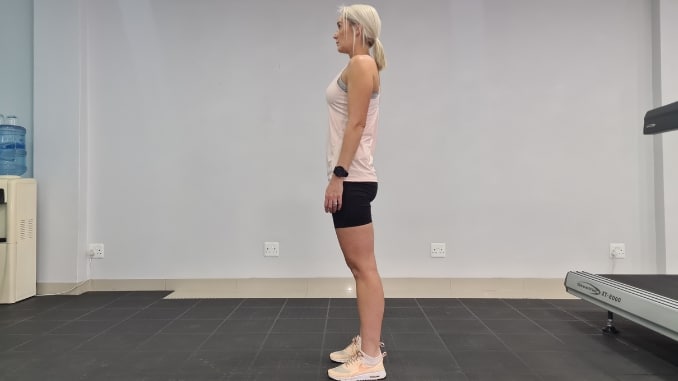 |
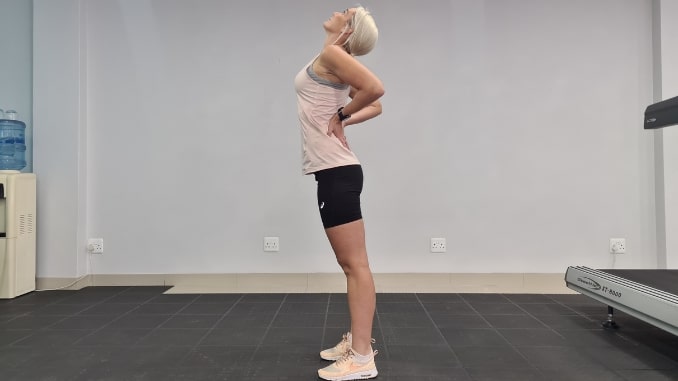 |
4. Standing Knee to Chest
Begin in an upright standing position with your feet hip-width apart, maintaining good alignment with your head, shoulders, hips, and legs. Engage your core. Shift your weight onto your left foot and lift your right leg to bring your knee towards your chest. Slowly lower your leg to return to the starting position and repeat the movement. After several repetitions, perform the movement on the opposite leg. Start with 1 set of 10 repetitions on each side.
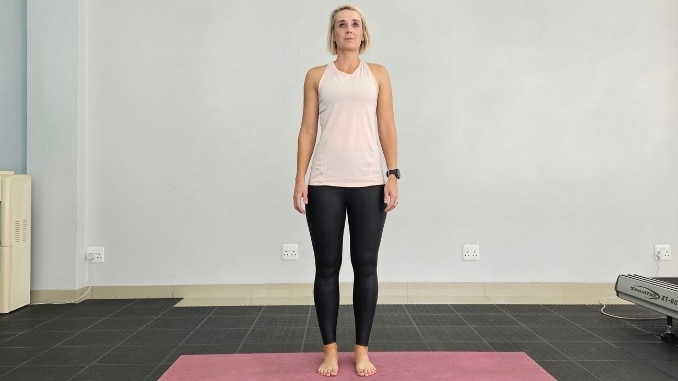 |
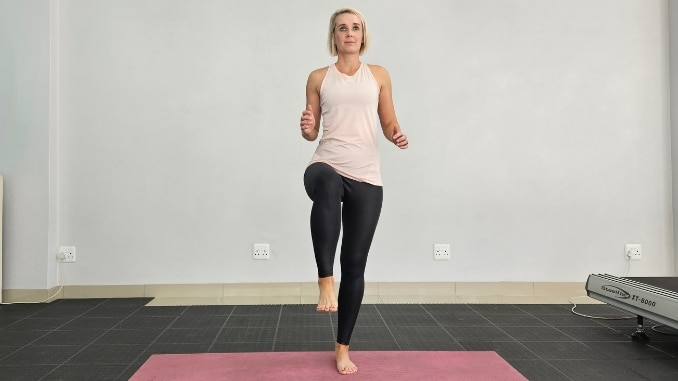 |
5. Reverse Bridge
For this exercise, you can use a ply box, chair, bench, or anything stable for balance.
Sit upright on the edge of a ply box or bench with your knees bent and feet flat on the floor, keeping your upper body straight. Place your hands at your sides on the ply box for support. Contract your core, push from your heels and arms, and arch your back to lift your seat off of the chair, bringing your head back. Hold this position for 5 seconds. Relax and slowly lower your hips to return to the starting position. Repeat the movement for 1 set with 10 repetitions.
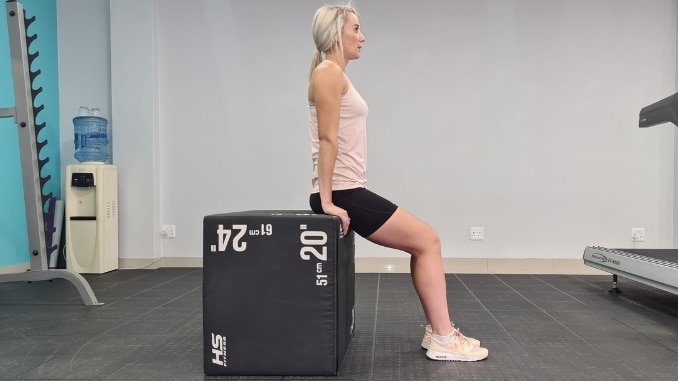 |
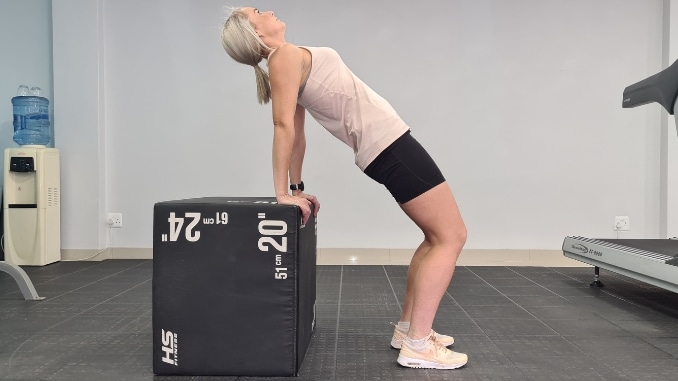 |
Tips for Proper Form and Technique

Maintaining proper form and technique is essential to prevent injuries and get the most out of your exercises. Here are some tips to keep in mind:
- Engage your core: Maintaining activation of your core muscles during exercises can assist in stabilizing your body and alleviating some stress on your knees.
- Align your knees with your toes: When performing exercises that involve bending or lunging, ensure that your knees are aligned with your toes. This alignment helps distribute the load evenly and reduces stress on the knees.
- Begin with a smaller range of motion: If you're new to exercise or experiencing significant knee pain, start with a smaller range of motion. Gradually increase the depth or intensity of the exercise as your knees become more robust and more comfortable.
- Control your movements: Avoid quick, jerky movements to prevent unnecessary stress on your hip muscles and knees. Focus on controlled and deliberate motions to reduce the risk of injury.
- Remember to breathe: Proper breathing techniques are essential during exercise. Breathe deeply and evenly, inhaling during the more accessible part of the movement and exhaling during the more challenging phase.
By following these tips, you can ensure you're performing exercises safely and beneficially for your knees.
Additional Considerations for Knee Pain Management
While exercise plays a crucial role in managing knee pain, there are additional considerations that can further enhance your knee health:
- Rest and Recovery: Giving your knees adequate rest between workouts prevents overuse injuries. Listen to your body and take breaks when needed.
- Weight Management: If you're overweight, losing excess weight can reduce the strain on your knees. Incorporate a balanced diet and healthy lifestyle habits to manage your weight effectively and prevent injury further.
- Hot and Cold Therapy: Utilizing heat or cold treatments on your knees can be beneficial in easing pain and diminishing inflammation. After exercising, you can employ ice packs or cold compresses to relieve knee pain. Conversely, before workouts, heat therapy options like warm showers or heating pads can provide relief.
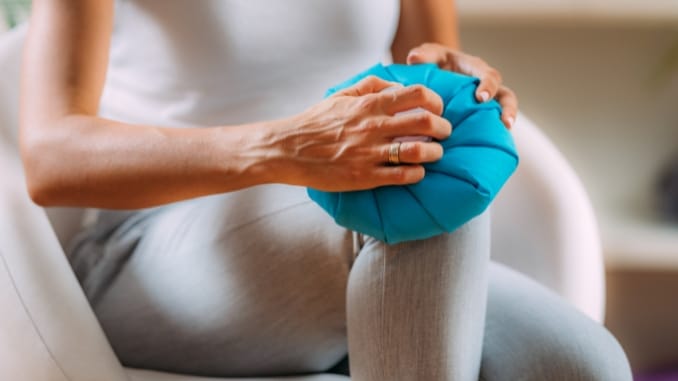
- Low-Impact Activities: Besides the exercises mentioned earlier, incorporating low-impact activities like walking, elliptical training, or using an elliptical machine can provide cardiovascular benefits without placing excessive pressure on the knees.
- Proper Nutrition: A balanced diet can support overall joint health. Incorporating foods rich in omega-3, antioxidants, and vitamins into your diet can assist in decreasing inflammation and supporting the healing process. Adopting a comprehensive approach to managing knee pain can enhance your outcomes and lead to sustained relief over the long term.
Taking a holistic approach to knee pain management can optimize your results and experience long-term relief.
Seeking Professional Help for Knee Pain

While exercise and self-care can effectively manage knee pain, knowing when to seek professional help is essential. If your pain is severe, enduring, or accompanied by other worrisome symptoms, it is recommended to seek guidance and help from a healthcare professional, such as a physical therapist. They can evaluate your condition, diagnose it correctly, and recommend targeted treatment options such as physical therapy, medications, or even surgery.
Remember, everyone's knee pain is unique, and what works for one person may not work for another. Collaborating closely with a healthcare professional can assist you in creating a personalized plan to address your specific needs and objectives.
Conclusion: Taking Care of Your Knees Through Exercise and Proper Care
Don't let knee pain hold you back any longer. You can improve mobility, relieve discomfort, and enhance your overall knee health with the right exercises and self-care strategies. Remember to start slowly, listen to your body, and consult with a healthcare professional if needed. By incorporating these five knee exercises and tips into your routine, you can take control of your joint health and enjoy a more active and pain-free lifestyle. Say goodbye to knee discomfort and hello to increased mobility with these exercises for bad knees. Let's get started on your journey to better knee health today.
So, say “Goodbye” to knee pain. Get instant access to the complete Knee Pain Solved program today!


